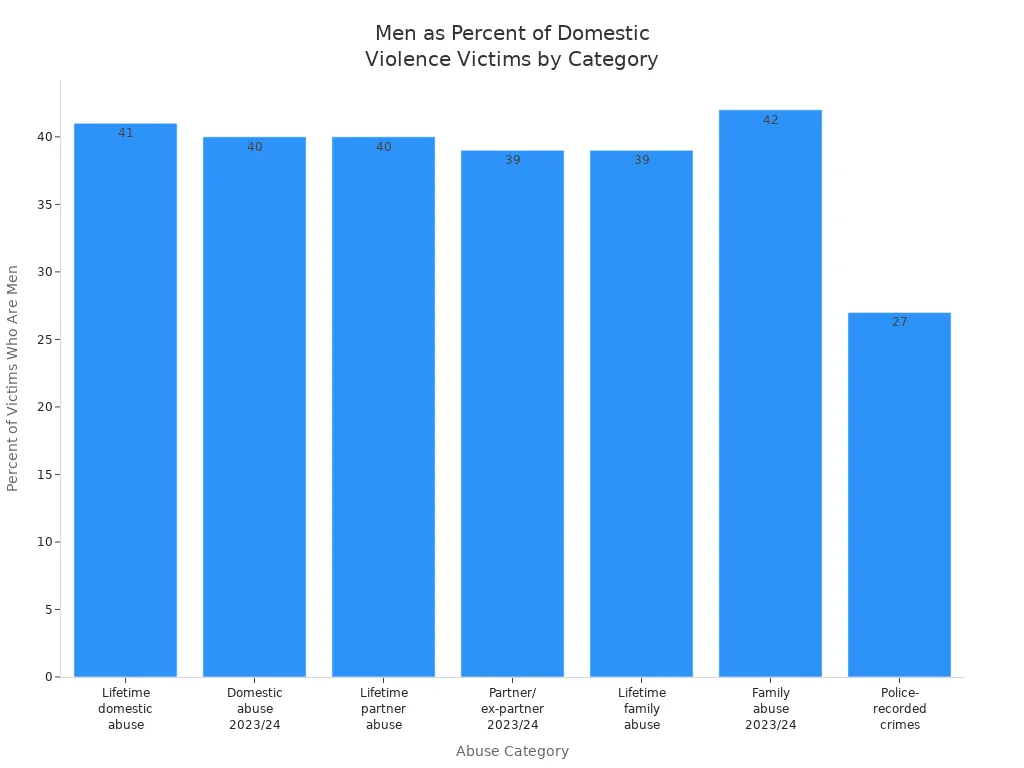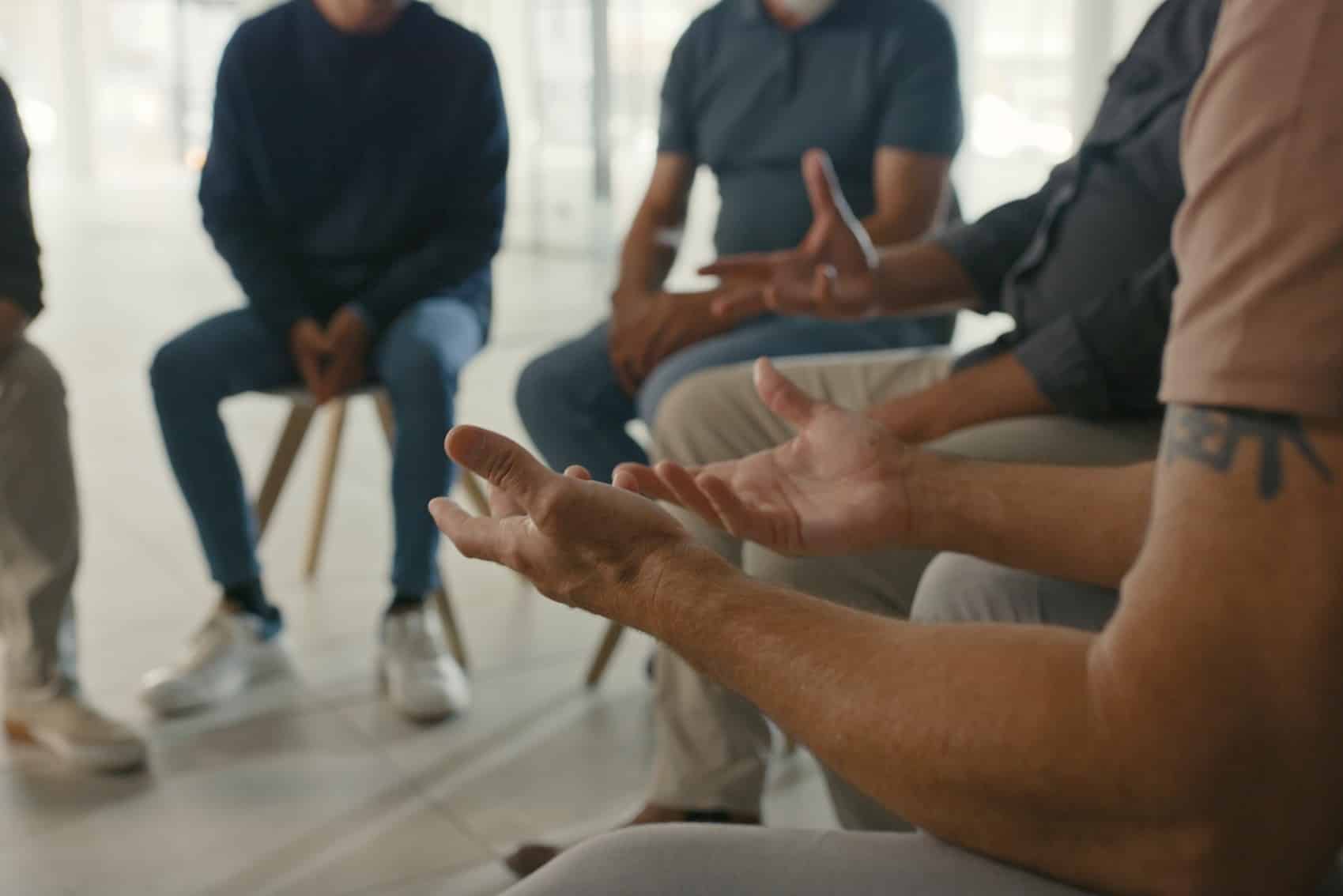Why Men as Domestic Violence Victims Are Still Ignored

Domestic violence against men is a significant problem that society often ignores. Many think domestic violence only involves physical harm, but intimate partner violence includes financial and psychological abuse as well. Studies show male victims face emotional and financial abuse but rarely report it due to social stigma and fear. They worry people will not believe them. The table below shows high rates of domestic violence against men:
Category of Abuse | Percentage of Men Victims | Percentage of All Victims Who Are Men |
|---|---|---|
Lifetime domestic abuse | 21.7% | 41% |
Domestic abuse in 2023/24 | 6.5% | 40% |
Lifetime partner abuse | 18.3% | 40% |
Partner/ex-partner abuse 2023/24 | 4.7% | 39% |
Lifetime family abuse | 6.9% | 39% |
Family abuse in 2023/24 | 2.6% | 42% |
Police-recorded domestic abuse crimes against men | N/A | 27% |

Domestic violence against men hurts families, children, and communities. Society needs recognition of all types of intimate partner violence to help survivors who need support. Unlike violence against women and girls, violence against men and boys often lacks proper recognition and resources.
Key Takeaways
Domestic violence against men affects many male victims, but societal perceptions often overlook it due to gender stereotypes and social expectations. Male victims experience physical, emotional, and financial abuse but face barriers to seeking help because they fear disbelief. Limited support agencies and missed opportunities in policy create challenges for male victims seeking identification and support. We need better recognition, legal reform, and improved support so every domestic abuse survivor feels respected and safe.
Stereotypes and Gender Roles

Gender Expectations
Traditional gender roles significantly affect how people view domestic violence against men. Society expects men to be strong and self-reliant, making it difficult to see male victims as needing help. These perceptions cause male victims to feel shame and embarrassment, preventing them from seeking support.
People expect men to handle problems alone without showing vulnerability
Society often assumes men are aggressors while ignoring female abusers
Support agencies and legal systems sometimes fail to accommodate male victims
Health professionals may lack training to recognize male victimization patterns
Social expectations and societal perceptions prevent male victims from discussing domestic violence against men. Most people assume women are always survivors and men are always perpetrators. This makes it nearly impossible for male victims to share their traumatic experiences. Many male victims stay silent because they fear judgment, ridicule, or being seen as weak.
When male victims do speak up, they often face disbelief or blame, which discourages other survivors from seeking help and creates barriers to seeking help.
Barriers to Reporting and Support
Reporting Challenges
Many male victims struggle to report domestic violence against men due to multiple barriers. They feel embarrassed or worry people won't believe them. Police and support organizations often focus only on physical injuries, making it difficult to address financial or psychological abuse. When male victims do report domestic relationships violence, they may face skepticism or blame.
Not Sure If You Are Been Gaslighted?
Sometimes it's hard to recognize gaslighting and emotional manipulation. Our Gaslighting Check app helps you identify patterns and provides personalized guidance based on your specific situation.
Try Gaslighting Check App NowInstitutional Neglect
Institutional neglect compounds these problems for male victims. Many services are designed exclusively for women, leaving male victims without appropriate resources. Police may dismiss male victims' reports or treat them as potential perpetrators rather than survivors. The justice system sometimes fails to prosecute female abusers or may even arrest male victims instead.
Limited funding for male-specific services creates significant support gaps
Many health professionals lack training in recognizing when male victims need identification and support
Media and policy often exclude male victims, making them feel invisible
Charity organizations and support agencies often focus primarily on female victims
Impact on Mental Health and Families

Mental Health Effects
Male victims experiencing domestic violence against men often develop serious mental health problems. Many suffer from higher rates of PTSD, depression, and anxiety compared to the general population. Some turn to substance abuse as a coping mechanism for their traumatic experiences.
Many male victims stay quiet because they fear being judged or do not know where to get help, creating missed opportunities for early intervention and support.
Family and Work Impact
Children living with domestic violence face significant challenges regardless of which parent is the victim. Young children may regress developmentally or become anxious, while school-age children often struggle academically and socially. These effects can persist into adulthood, affecting their ability to form healthy domestic relationships.
Domestic violence against men also impacts work productivity and economic stability. About half of male victims report that violence affects their job performance, leading to missed work, decreased productivity, and sometimes job loss.
Solutions and Progress
Raising Awareness
Addressing domestic violence against men requires comprehensive changes across multiple systems. Education and training programs help challenge stereotypes and show that anyone can be a victim. Public campaigns like #1Thing and #ThisIsDV use social media to raise recognition about male victims and provide opportunities for education.
Community programs focus on building empathy and understanding for all survivors. Charity organizations are beginning to expand their services to include male victims, though more work is needed to achieve equal recognition and support.
Legal and Policy Reform
Legal reforms have made domestic violence laws more gender-neutral, protecting all people regardless of gender. However, the justice system still needs better training to treat all survivors fairly and prosecute all perpetrators appropriately. Policy changes must address the unique challenges faced by male victims.
Support Services
Support services are gradually expanding to include male victims. Some locations now offer male-specific shelters and counseling services. Telehealth options help male victims who cannot access in-person services. However, many male victims still worry about judgment or disbelief when seeking help.
Many male victims feel alone when they ask for help and need better opportunities for connection
Some worry about losing their children or being called liars, creating additional barriers to seeking help
More support and understanding can help male victims heal and rebuild their lives
Progress requires continued effort to help all survivors heal and rebuild their lives, regardless of gender. Every domestic abuse survivor deserves recognition, empathy, and comprehensive support.
Moving Forward
Many male victims remain overlooked as domestic violence against men survivors due to persistent stereotypes and inadequate support systems. Addressing this requires:
Challenging assumptions that abuse only affects women
Increasing funding and resources for male-specific services and support agencies
Training health professionals to recognize and respond to male victims
Creating more opportunities for identification and support in healthcare settings
Developing policy initiatives that address the specific needs of male victims
Everyone deserves safety and respect. By fighting stereotypes, improving support systems, and showing empathy, we can help all survivors find hope and healing while creating better opportunities for recognition and support.
Frequently Asked Questions
What types of abuse can male victims experience in domestic violence?
Male victims can face physical, emotional, psychological, and financial abuse. Some experience threats, control over daily activities, or gaslighting. Abuse doesn't always leave visible marks, and non-physical abuse is often overlooked by health professionals and support agencies.
Why do male victims often not report domestic violence?
Male victims face social stigma and fear disbelief. Society expects men to be strong, making it difficult to admit victimization. Many worry about losing respect or being blamed for the abuse, creating significant barriers to seeking help.
Are there shelters or support services for male victims?
Some shelters and hotlines help male victims, but most services focus on women. Male victims may find fewer safe spaces or counseling options. Some cities now offer specialized programs, and online support provides new opportunities for help.
How does domestic violence affect children in the home?
Children who witness abuse may feel scared, anxious, or confused about domestic relationships. Some struggle in school or have difficulty forming relationships. These traumatic experiences can persist into adulthood, requiring professional support from health professionals.
What can society do to help male victims of domestic violence?
Society can educate people that anyone can be a victim and work to change societal perceptions. Schools and workplaces should provide information and support opportunities. Training for police and service workers is essential, and everyone should listen to and believe male victims who seek help. Charity organizations and policy makers must show empathy and create inclusive support systems.